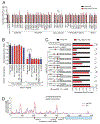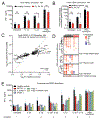Human MCTS1-dependent translation of JAK2 is essential for IFN-γ immunity to mycobacteria
- PMID: 37875108
- PMCID: PMC10841658
- DOI: 10.1016/j.cell.2023.09.024
Human MCTS1-dependent translation of JAK2 is essential for IFN-γ immunity to mycobacteria
Abstract
Human inherited disorders of interferon-gamma (IFN-γ) immunity underlie severe mycobacterial diseases. We report X-linked recessive MCTS1 deficiency in men with mycobacterial disease from kindreds of different ancestries (from China, Finland, Iran, and Saudi Arabia). Complete deficiency of this translation re-initiation factor impairs the translation of a subset of proteins, including the kinase JAK2 in all cell types tested, including T lymphocytes and phagocytes. JAK2 expression is sufficiently low to impair cellular responses to interleukin-23 (IL-23) and partially IL-12, but not other JAK2-dependent cytokines. Defective responses to IL-23 preferentially impair the production of IFN-γ by innate-like adaptive mucosal-associated invariant T cells (MAIT) and γδ T lymphocytes upon mycobacterial challenge. Surprisingly, the lack of MCTS1-dependent translation re-initiation and ribosome recycling seems to be otherwise physiologically redundant in these patients. These findings suggest that X-linked recessive human MCTS1 deficiency underlies isolated mycobacterial disease by impairing JAK2 translation in innate-like adaptive T lymphocytes, thereby impairing the IL-23-dependent induction of IFN-γ.
Keywords: IL-23; JAK2; MCTS1; MSMD; X-linked disease; inborn error of immunity; mycobacterium; translation re-initiation.
Copyright © 2023 The Author(s). Published by Elsevier Inc. All rights reserved.
Conflict of interest statement
Declaration of interests J.-L.C. serves on the scientific advisory boards of ADMA Biologics Inc., Kymera Therapeutics, and Elixiron Immunotherapeutics.
Figures







References
Publication types
MeSH terms
Substances
Grants and funding
LinkOut - more resources
Full Text Sources
Medical
Molecular Biology Databases
Miscellaneous

